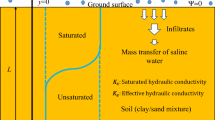Abstract
This research discusses the main factors effecting the permeability reduction due to cement infiltration or top soil masking when cement infiltrates in a river sediment matrix. This is relevant to the migration of pollutants to the groundwater through surface water infiltration, which is an important and urgent problem to resolve. A series of indoor infiltration simulations were performed to measure the infiltration reduction when the cement infiltrate in a selected soil matrix under different conditions (e.g. dry density, postponing time and waterhead, etc.). The infiltration in the cement-treated samples was compared with a reference infiltration with no cement masking or infiltrating. It was found that the infiltration rates of the cement-treated soils were consistently lower than the control sample, indicating an infiltration reduction due to cement infiltration. The average reduction ranged 3.59-44.33% depending on different processing methods. In this paper, some main factors affecting the permeability-reducing effect of cement infiltration in a river sediment matrix, such as the soil texture, dry density, postponing time of water supply, initial waterhead, and cement addition quantity, are discussed, and theories regarding cement infiltration mechanisms are presented.
Similar content being viewed by others
References
Alley, W. M., Healy, R. W., LaBaugh, J. W., and Reilly, T. E. (2002). “Flow and storage in groundwater systems.” Science, Vol. 296, No. 5575, pp. 1985–1990, DOI: 10.1126/science.1067123.
ASTM (2007a). Standard test method for measurement of hydraulic conductivity of porous material using a rigid-wall, compaction-mold permeameter, D5856, 1995, West Conshohocken, PA.
Bekhita, H. M., Mohamed, A. E., and Ahmed, E. H. (2009). “Contaminant Transport in groundwater in the presence of colloids and bacteria: model development and verificatio.” J. of Contaminant Hydrology, Vol. 108, No. 9, pp. 152–167, DOI: 10.1016/j.jconhyd.2009.07.003.
Bezuijen, A. (2010). Compensation grouting in sand: Experiments, field experiences and mechanisms, PhD Thesis, Delft University Netherlands.
Franzluebbers, A. J. (2002). “Water infiltration and soil structure related to organic matter and its stratification with depth.” Soil Tillage Res., Vol. 66, No. 2, pp. 197–205, DOI: 10.1016/S0167-1987(02)00027-2.
Hajiaghaei, A., Rashidi, M., Sadeghi, M. A., Gholami, M., and Jaberinasa, B. (2014). “Prediction of soil infiltration rate based on silt and clay content of soil.” American-Eurasian J. Agric. & Environ. Sci., Vol. 14, No. 8, pp. 702–706, DOI: 10.5829/idosi.aejaes.2014.14.08.12394.
Helalia, A. M. (1993). “The relation between soil infiltration and effective Porosity in different soil Agric.” Water Mgmt, Vol. 24, No. 8, pp. 39–47, DOI: 10.1016/0378-3774(93)90060-N.
Hyung, K. P. and Young, C. C. (2013). “Prediction of cement infiltration depth in coarse-grained Soil.” KSCE J. of Civil Eng., Vol. 17, No. 5, pp. 886–894, DOI: 10.1007/s12205-013-0288-y.
Ji, J. L. and Fan, G. S. (2014a). “Study on infiltration-reducing effect of cement infiltrating into the riverbed alluvial silt.” J. Irrig. and Drain., Vol. 33, No. 3, pp. 110–114.
Ji, J. L. and Fan, G. S. (2014b). “Study on infiltration-reducing effect of using different cement-adding methods to the riverbed alluvial silt.” J. of Taiyuan Univ. Tech, Vol. 45, No. 7, pp. 480–484.
Jin, Z. F., Wang, F. E., and Chen, Y. X. (2004). “Nitrate pollution of groundwater in urban area.” Acta Pedologica Sinica, Vol. 4, No. 2, pp. 252–257.
Kalinski, M. E. and Yerra, P. K. (2006). “Hydraulic conductivity of compacted cement-stabilized fly ash.” Fuel, Vol. 85, pp. 2330–2336. DOI: 10.1016/j.fuel.2006.04.030.
Keijzer, T. J. S. and Loch, J. P. G. (2000). “Chemical osmosis in compacted dredging sludge.” Soil Sci Soc Am, Vol. 65, No. 4, pp. 1045–1051, DOI:10.2136/sssaj2001.6541045x.
Li, H. X. and Fang, S. (2009). “Experimental study on main factors influencing the infiltration capacity of unsaturated earth canal.” J. Hydrau. Eng., Vol. 40, No. 5, pp. 630–634.
Li, Z., Wu, T. P., Feng, H., Zhao, X. N., and Huang, J. (2009a). “Effects of soil clay particle content on soil infiltration capacity by simulated experiments.” Agric. Res. in the Arid Areas, Vol. 27, No. 5, pp. 71–77.
Li, Z., Wu, T. P., Feng, H., Zhao, X. N., and Huang, J. (2009b). “Simulated experiment on effect of soil bulk density on soil infiltration capacity.” Transactions of the CSAE, Vol. 25, No. 6, pp. 40–45.
Martin, W. D., Kaye N. B., and Putman, B. J. (2014). “Effects of aggregate masking on soil infiltration under an aggregate bed.” J. Irrig. Drain. Eng., Vol. 141, No. 2, pp. 879–884, DOI: 10.1061/(ASCE)IR.1943-4774.0000879.
Samtani, N. C. and Edward, A. N. (2006). Soils and foundations reference manual, FHWA Manual.
Sergio, F. (2014). “Electrokinetic Barriers for Preventing Groundwater Pollution.” Encyclopedia of Applied Electrochemistry, Vol. 9, pp. 719–723, DOI: 10.1007/978-1-4419-6996-5-115.
Sun, Y. X., Fan, G. S., and Ji, J. L. (2014). “Study on the effect of effective water head of cement on permeability function of soil matrix.” Yellow River., Vol. 36, No. 12, pp. 85–87.
Yang, B. (2007). Cement soil strength properties, PhD diss. Shanghai, Shanghai Jiao Tong Univ.
Zhang, Y., Liu, C. L, Lv, D. Y., and Wang, Z. L. (2013). “Investigation of groundwater pollution prevention strategies.” Chinese Society for Environmental Sciences Annual Conference, Chinese Society for Environmental Sciences pp. 3081–3091. Kunming. China Environmental Science Press.
Author information
Authors and Affiliations
Corresponding author
Rights and permissions
About this article
Cite this article
Ji, J., Fan, G. Analysis of the main factors influencing the permeability-reducing effect of cement infiltration in a river sediment matrix. KSCE J Civ Eng 21, 616–622 (2017). https://doi.org/10.1007/s12205-016-0599-x
Received:
Accepted:
Published:
Issue Date:
DOI: https://doi.org/10.1007/s12205-016-0599-x




